Toyota Management and Operations
VerifiedAdded on 2020/12/29
|15
|4481
|217
Report
AI Summary
This report analyzes Toyota's management and operations, exploring the roles of leaders and managers, different leadership and management theories, key operational approaches, and external factors influencing decision-making. It examines how Toyota utilizes strategies like Just-in-Time, Six Sigma, and Lean Production to achieve operational efficiencies and meet business objectives.
Contribute Materials
Your contribution can guide someone’s learning journey. Share your
documents today.
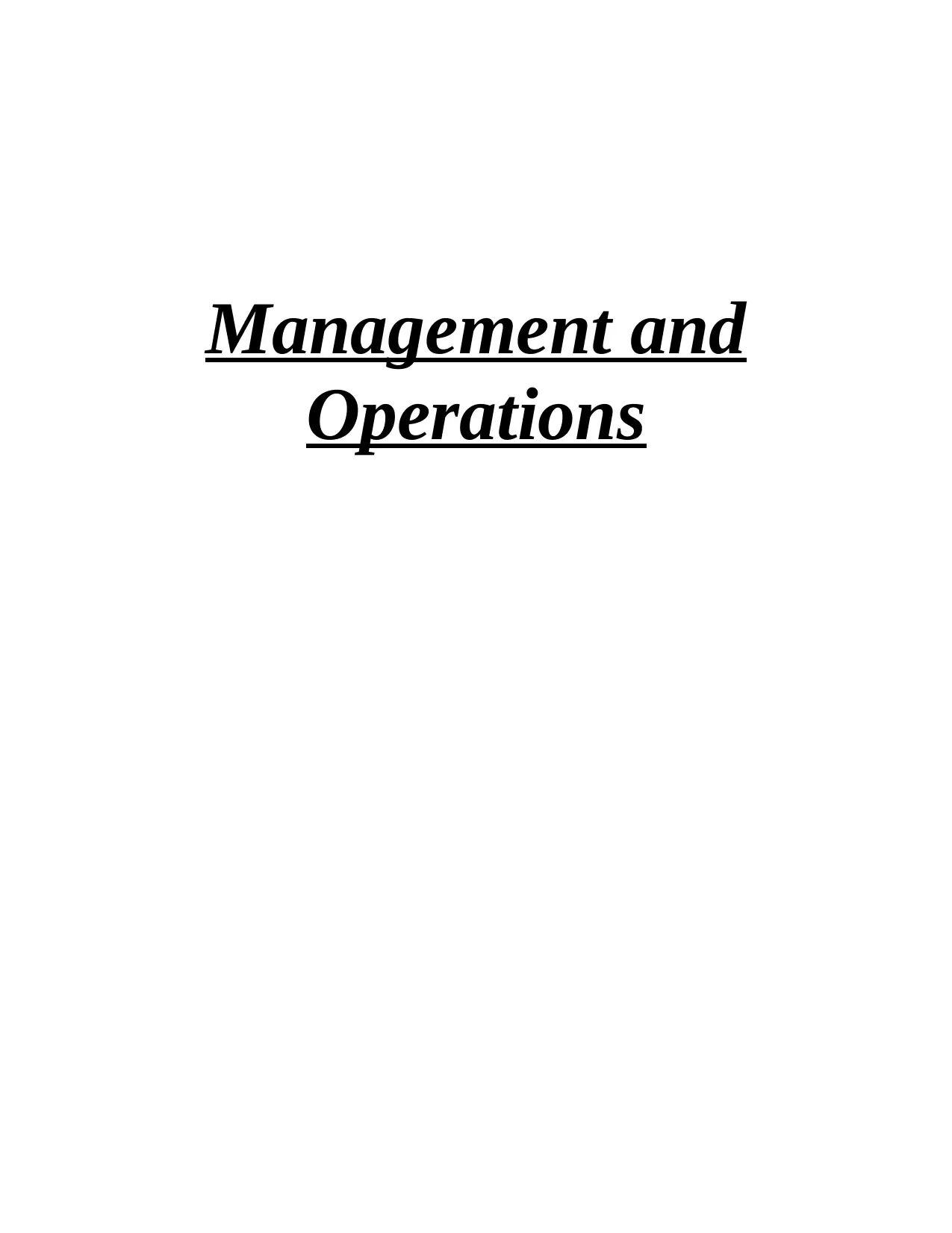
Management and
Operations
Operations
Secure Best Marks with AI Grader
Need help grading? Try our AI Grader for instant feedback on your assignments.
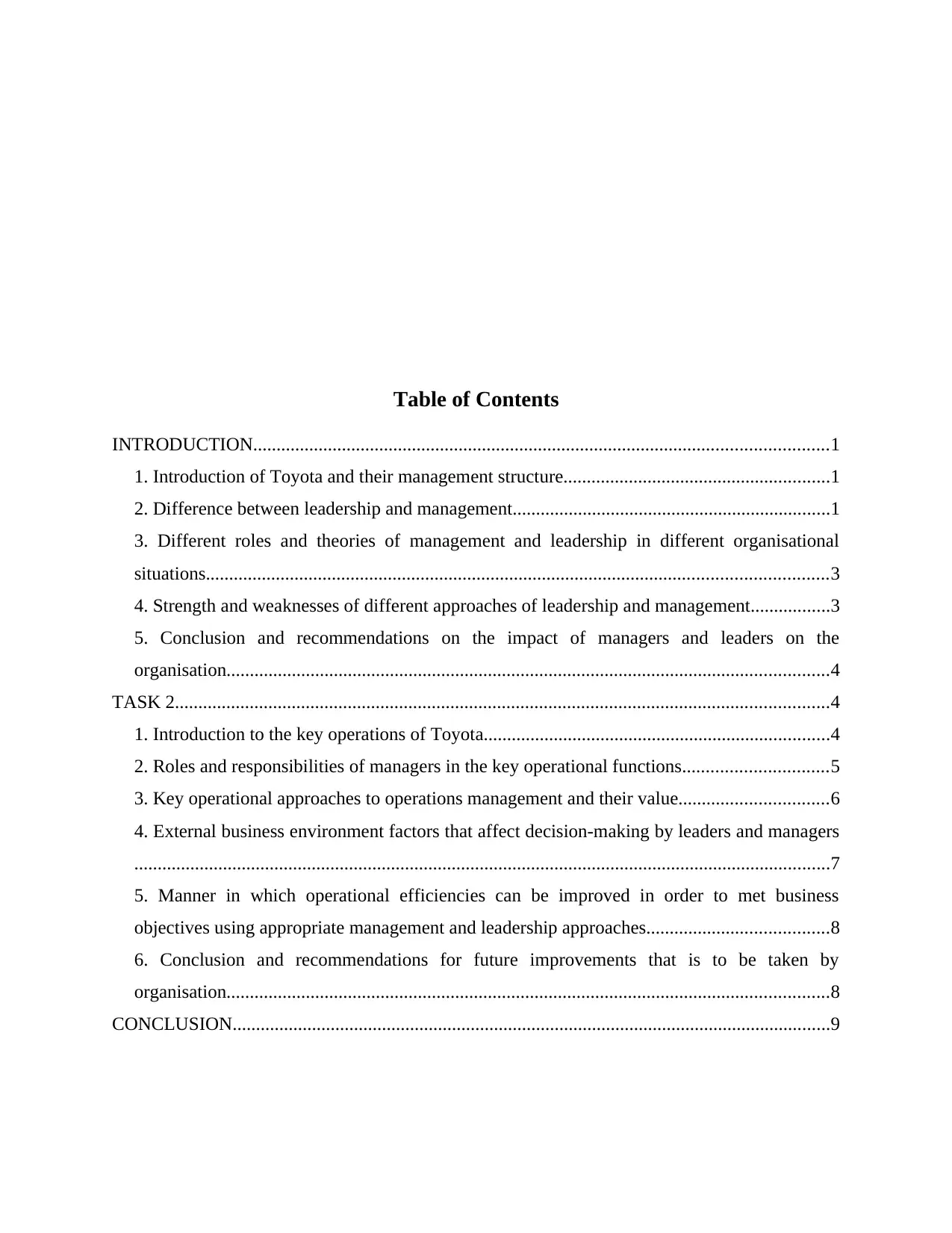
Table of Contents
INTRODUCTION...........................................................................................................................1
1. Introduction of Toyota and their management structure.........................................................1
2. Difference between leadership and management....................................................................1
3. Different roles and theories of management and leadership in different organisational
situations.....................................................................................................................................3
4. Strength and weaknesses of different approaches of leadership and management.................3
5. Conclusion and recommendations on the impact of managers and leaders on the
organisation.................................................................................................................................4
TASK 2............................................................................................................................................4
1. Introduction to the key operations of Toyota..........................................................................4
2. Roles and responsibilities of managers in the key operational functions...............................5
3. Key operational approaches to operations management and their value................................6
4. External business environment factors that affect decision-making by leaders and managers
.....................................................................................................................................................7
5. Manner in which operational efficiencies can be improved in order to met business
objectives using appropriate management and leadership approaches.......................................8
6. Conclusion and recommendations for future improvements that is to be taken by
organisation.................................................................................................................................8
CONCLUSION................................................................................................................................9
INTRODUCTION...........................................................................................................................1
1. Introduction of Toyota and their management structure.........................................................1
2. Difference between leadership and management....................................................................1
3. Different roles and theories of management and leadership in different organisational
situations.....................................................................................................................................3
4. Strength and weaknesses of different approaches of leadership and management.................3
5. Conclusion and recommendations on the impact of managers and leaders on the
organisation.................................................................................................................................4
TASK 2............................................................................................................................................4
1. Introduction to the key operations of Toyota..........................................................................4
2. Roles and responsibilities of managers in the key operational functions...............................5
3. Key operational approaches to operations management and their value................................6
4. External business environment factors that affect decision-making by leaders and managers
.....................................................................................................................................................7
5. Manner in which operational efficiencies can be improved in order to met business
objectives using appropriate management and leadership approaches.......................................8
6. Conclusion and recommendations for future improvements that is to be taken by
organisation.................................................................................................................................8
CONCLUSION................................................................................................................................9

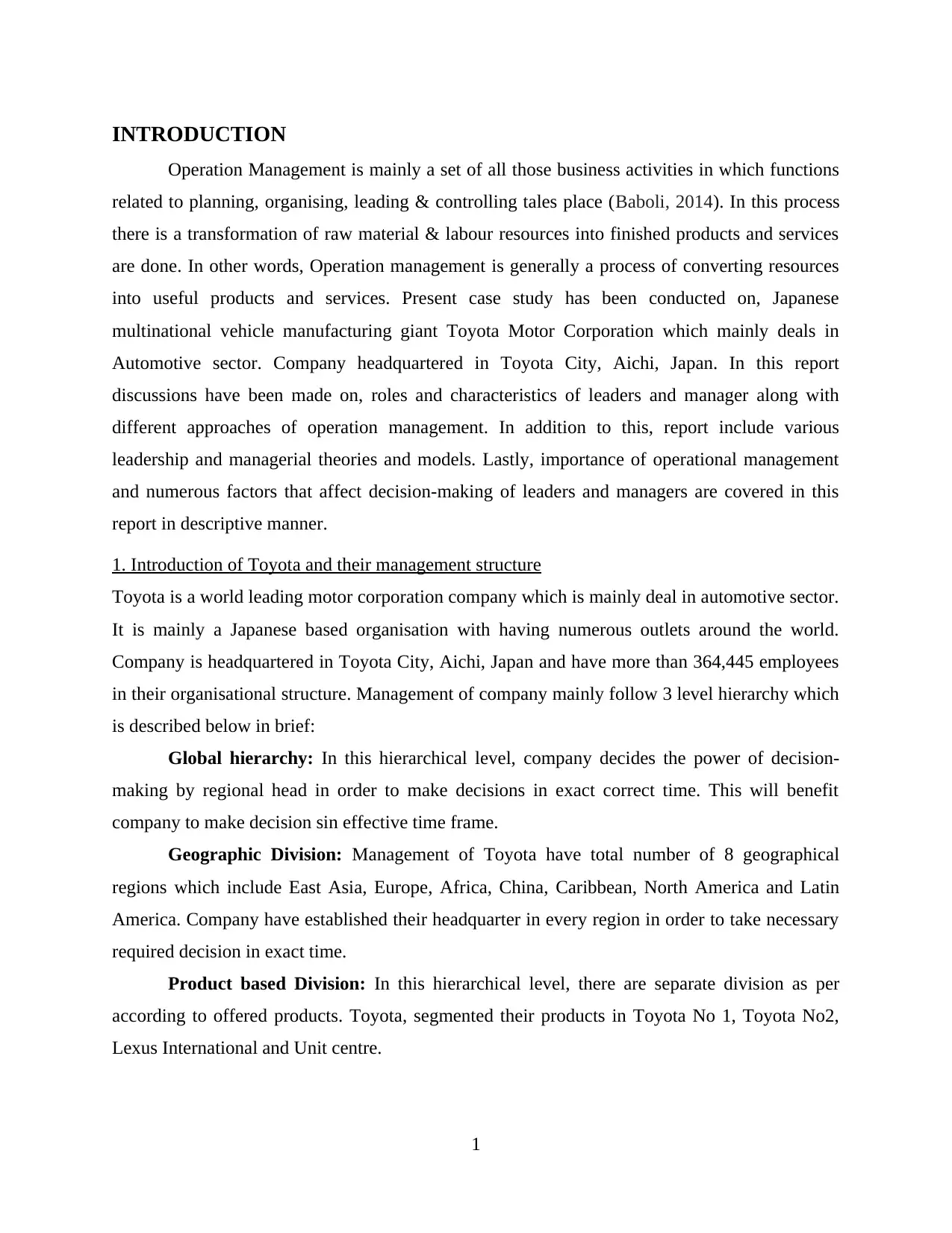
INTRODUCTION
Operation Management is mainly a set of all those business activities in which functions
related to planning, organising, leading & controlling tales place (Baboli, 2014). In this process
there is a transformation of raw material & labour resources into finished products and services
are done. In other words, Operation management is generally a process of converting resources
into useful products and services. Present case study has been conducted on, Japanese
multinational vehicle manufacturing giant Toyota Motor Corporation which mainly deals in
Automotive sector. Company headquartered in Toyota City, Aichi, Japan. In this report
discussions have been made on, roles and characteristics of leaders and manager along with
different approaches of operation management. In addition to this, report include various
leadership and managerial theories and models. Lastly, importance of operational management
and numerous factors that affect decision-making of leaders and managers are covered in this
report in descriptive manner.
1. Introduction of Toyota and their management structure
Toyota is a world leading motor corporation company which is mainly deal in automotive sector.
It is mainly a Japanese based organisation with having numerous outlets around the world.
Company is headquartered in Toyota City, Aichi, Japan and have more than 364,445 employees
in their organisational structure. Management of company mainly follow 3 level hierarchy which
is described below in brief:
Global hierarchy: In this hierarchical level, company decides the power of decision-
making by regional head in order to make decisions in exact correct time. This will benefit
company to make decision sin effective time frame.
Geographic Division: Management of Toyota have total number of 8 geographical
regions which include East Asia, Europe, Africa, China, Caribbean, North America and Latin
America. Company have established their headquarter in every region in order to take necessary
required decision in exact time.
Product based Division: In this hierarchical level, there are separate division as per
according to offered products. Toyota, segmented their products in Toyota No 1, Toyota No2,
Lexus International and Unit centre.
1
Operation Management is mainly a set of all those business activities in which functions
related to planning, organising, leading & controlling tales place (Baboli, 2014). In this process
there is a transformation of raw material & labour resources into finished products and services
are done. In other words, Operation management is generally a process of converting resources
into useful products and services. Present case study has been conducted on, Japanese
multinational vehicle manufacturing giant Toyota Motor Corporation which mainly deals in
Automotive sector. Company headquartered in Toyota City, Aichi, Japan. In this report
discussions have been made on, roles and characteristics of leaders and manager along with
different approaches of operation management. In addition to this, report include various
leadership and managerial theories and models. Lastly, importance of operational management
and numerous factors that affect decision-making of leaders and managers are covered in this
report in descriptive manner.
1. Introduction of Toyota and their management structure
Toyota is a world leading motor corporation company which is mainly deal in automotive sector.
It is mainly a Japanese based organisation with having numerous outlets around the world.
Company is headquartered in Toyota City, Aichi, Japan and have more than 364,445 employees
in their organisational structure. Management of company mainly follow 3 level hierarchy which
is described below in brief:
Global hierarchy: In this hierarchical level, company decides the power of decision-
making by regional head in order to make decisions in exact correct time. This will benefit
company to make decision sin effective time frame.
Geographic Division: Management of Toyota have total number of 8 geographical
regions which include East Asia, Europe, Africa, China, Caribbean, North America and Latin
America. Company have established their headquarter in every region in order to take necessary
required decision in exact time.
Product based Division: In this hierarchical level, there are separate division as per
according to offered products. Toyota, segmented their products in Toyota No 1, Toyota No2,
Lexus International and Unit centre.
1
Secure Best Marks with AI Grader
Need help grading? Try our AI Grader for instant feedback on your assignments.
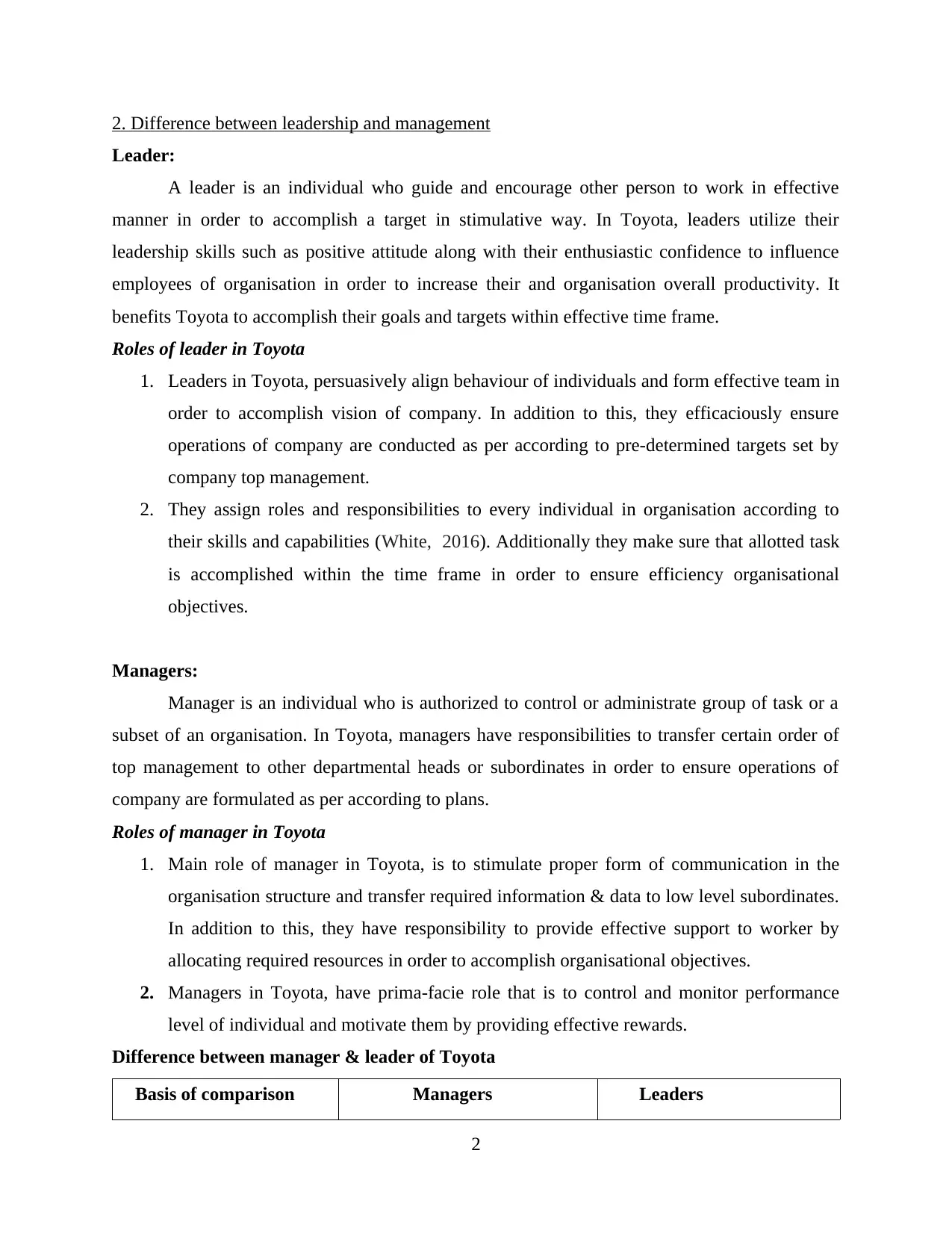
2. Difference between leadership and management
Leader:
A leader is an individual who guide and encourage other person to work in effective
manner in order to accomplish a target in stimulative way. In Toyota, leaders utilize their
leadership skills such as positive attitude along with their enthusiastic confidence to influence
employees of organisation in order to increase their and organisation overall productivity. It
benefits Toyota to accomplish their goals and targets within effective time frame.
Roles of leader in Toyota
1. Leaders in Toyota, persuasively align behaviour of individuals and form effective team in
order to accomplish vision of company. In addition to this, they efficaciously ensure
operations of company are conducted as per according to pre-determined targets set by
company top management.
2. They assign roles and responsibilities to every individual in organisation according to
their skills and capabilities (White, 2016). Additionally they make sure that allotted task
is accomplished within the time frame in order to ensure efficiency organisational
objectives.
Managers:
Manager is an individual who is authorized to control or administrate group of task or a
subset of an organisation. In Toyota, managers have responsibilities to transfer certain order of
top management to other departmental heads or subordinates in order to ensure operations of
company are formulated as per according to plans.
Roles of manager in Toyota
1. Main role of manager in Toyota, is to stimulate proper form of communication in the
organisation structure and transfer required information & data to low level subordinates.
In addition to this, they have responsibility to provide effective support to worker by
allocating required resources in order to accomplish organisational objectives.
2. Managers in Toyota, have prima-facie role that is to control and monitor performance
level of individual and motivate them by providing effective rewards.
Difference between manager & leader of Toyota
Basis of comparison Managers Leaders
2
Leader:
A leader is an individual who guide and encourage other person to work in effective
manner in order to accomplish a target in stimulative way. In Toyota, leaders utilize their
leadership skills such as positive attitude along with their enthusiastic confidence to influence
employees of organisation in order to increase their and organisation overall productivity. It
benefits Toyota to accomplish their goals and targets within effective time frame.
Roles of leader in Toyota
1. Leaders in Toyota, persuasively align behaviour of individuals and form effective team in
order to accomplish vision of company. In addition to this, they efficaciously ensure
operations of company are conducted as per according to pre-determined targets set by
company top management.
2. They assign roles and responsibilities to every individual in organisation according to
their skills and capabilities (White, 2016). Additionally they make sure that allotted task
is accomplished within the time frame in order to ensure efficiency organisational
objectives.
Managers:
Manager is an individual who is authorized to control or administrate group of task or a
subset of an organisation. In Toyota, managers have responsibilities to transfer certain order of
top management to other departmental heads or subordinates in order to ensure operations of
company are formulated as per according to plans.
Roles of manager in Toyota
1. Main role of manager in Toyota, is to stimulate proper form of communication in the
organisation structure and transfer required information & data to low level subordinates.
In addition to this, they have responsibility to provide effective support to worker by
allocating required resources in order to accomplish organisational objectives.
2. Managers in Toyota, have prima-facie role that is to control and monitor performance
level of individual and motivate them by providing effective rewards.
Difference between manager & leader of Toyota
Basis of comparison Managers Leaders
2
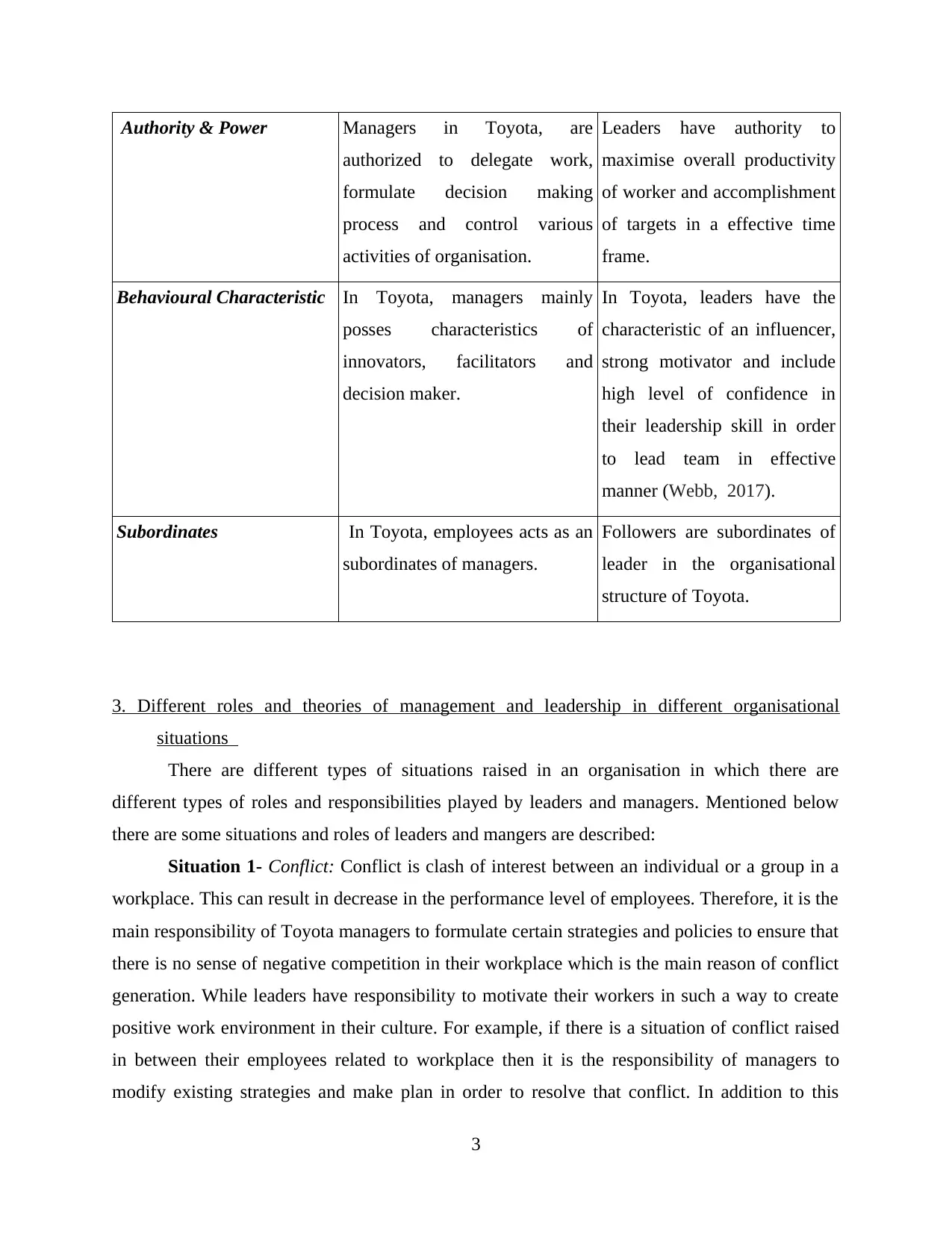
Authority & Power Managers in Toyota, are
authorized to delegate work,
formulate decision making
process and control various
activities of organisation.
Leaders have authority to
maximise overall productivity
of worker and accomplishment
of targets in a effective time
frame.
Behavioural Characteristic In Toyota, managers mainly
posses characteristics of
innovators, facilitators and
decision maker.
In Toyota, leaders have the
characteristic of an influencer,
strong motivator and include
high level of confidence in
their leadership skill in order
to lead team in effective
manner (Webb, 2017).
Subordinates In Toyota, employees acts as an
subordinates of managers.
Followers are subordinates of
leader in the organisational
structure of Toyota.
3. Different roles and theories of management and leadership in different organisational
situations
There are different types of situations raised in an organisation in which there are
different types of roles and responsibilities played by leaders and managers. Mentioned below
there are some situations and roles of leaders and mangers are described:
Situation 1- Conflict: Conflict is clash of interest between an individual or a group in a
workplace. This can result in decrease in the performance level of employees. Therefore, it is the
main responsibility of Toyota managers to formulate certain strategies and policies to ensure that
there is no sense of negative competition in their workplace which is the main reason of conflict
generation. While leaders have responsibility to motivate their workers in such a way to create
positive work environment in their culture. For example, if there is a situation of conflict raised
in between their employees related to workplace then it is the responsibility of managers to
modify existing strategies and make plan in order to resolve that conflict. In addition to this
3
authorized to delegate work,
formulate decision making
process and control various
activities of organisation.
Leaders have authority to
maximise overall productivity
of worker and accomplishment
of targets in a effective time
frame.
Behavioural Characteristic In Toyota, managers mainly
posses characteristics of
innovators, facilitators and
decision maker.
In Toyota, leaders have the
characteristic of an influencer,
strong motivator and include
high level of confidence in
their leadership skill in order
to lead team in effective
manner (Webb, 2017).
Subordinates In Toyota, employees acts as an
subordinates of managers.
Followers are subordinates of
leader in the organisational
structure of Toyota.
3. Different roles and theories of management and leadership in different organisational
situations
There are different types of situations raised in an organisation in which there are
different types of roles and responsibilities played by leaders and managers. Mentioned below
there are some situations and roles of leaders and mangers are described:
Situation 1- Conflict: Conflict is clash of interest between an individual or a group in a
workplace. This can result in decrease in the performance level of employees. Therefore, it is the
main responsibility of Toyota managers to formulate certain strategies and policies to ensure that
there is no sense of negative competition in their workplace which is the main reason of conflict
generation. While leaders have responsibility to motivate their workers in such a way to create
positive work environment in their culture. For example, if there is a situation of conflict raised
in between their employees related to workplace then it is the responsibility of managers to
modify existing strategies and make plan in order to resolve that conflict. In addition to this
3

leaders by taking advantage of effective leadership skill can motivate tier employees to work in
effective manner.
Situation 2- Decision-making: It is the core essence of every organisation in order to run
their overall organisation functions in smooth and effective manner (Morschett, 2015).
Therefore, it is the basic responsibility of Toyota managers to formulate systematic strategies to
accomplish company pre-determined goals and targets in proper time frame. In the process of
decision making both leaders and manager perform different roles. For example, if top
management of Toyota is looking forward to expand their operations in other geographical
location then in this scenario related decisions is required to be taken by leaders and plans to
implement those decisions are required to be made by mangers. For this, both leaders and
managers can take advantage of contingency theory to make the process of decision-making
effective. In relation to this, leaders are required to make certain decision with the help of which
company can increase their productivity while, managers are required to formulate measure with
the help of which they can acquire those targets.
4. Strength and weaknesses of different approaches of leadership and management
In context with Toyota, their leaders and managers take advantage of leadership and
management theories to accomplish their roles and responsibilities. Some of the theories are
mentioned below:
Transformational theory of leadership:
In this model of integrity leaders work in a team to evaluate need of change and then
develop proper vision to accomplish that change. This theory will benefit leader of Toyota, to
ensure behaviour of workers and encourage them in effective manner in order to make them
committed towards their work. With the help of this theory leader can ensure that organisation
overall objectives are accomplished in a time frame as per desired targets of company top
management.
STRENGTH WEAKNESSES
This theory allow quick formation of vision
and promote enthusiasm.
It is a time taking process in which there is a
serious challenge of detailing.
Classical theory of Management
4
effective manner.
Situation 2- Decision-making: It is the core essence of every organisation in order to run
their overall organisation functions in smooth and effective manner (Morschett, 2015).
Therefore, it is the basic responsibility of Toyota managers to formulate systematic strategies to
accomplish company pre-determined goals and targets in proper time frame. In the process of
decision making both leaders and manager perform different roles. For example, if top
management of Toyota is looking forward to expand their operations in other geographical
location then in this scenario related decisions is required to be taken by leaders and plans to
implement those decisions are required to be made by mangers. For this, both leaders and
managers can take advantage of contingency theory to make the process of decision-making
effective. In relation to this, leaders are required to make certain decision with the help of which
company can increase their productivity while, managers are required to formulate measure with
the help of which they can acquire those targets.
4. Strength and weaknesses of different approaches of leadership and management
In context with Toyota, their leaders and managers take advantage of leadership and
management theories to accomplish their roles and responsibilities. Some of the theories are
mentioned below:
Transformational theory of leadership:
In this model of integrity leaders work in a team to evaluate need of change and then
develop proper vision to accomplish that change. This theory will benefit leader of Toyota, to
ensure behaviour of workers and encourage them in effective manner in order to make them
committed towards their work. With the help of this theory leader can ensure that organisation
overall objectives are accomplished in a time frame as per desired targets of company top
management.
STRENGTH WEAKNESSES
This theory allow quick formation of vision
and promote enthusiasm.
It is a time taking process in which there is a
serious challenge of detailing.
Classical theory of Management
4
Paraphrase This Document
Need a fresh take? Get an instant paraphrase of this document with our AI Paraphraser
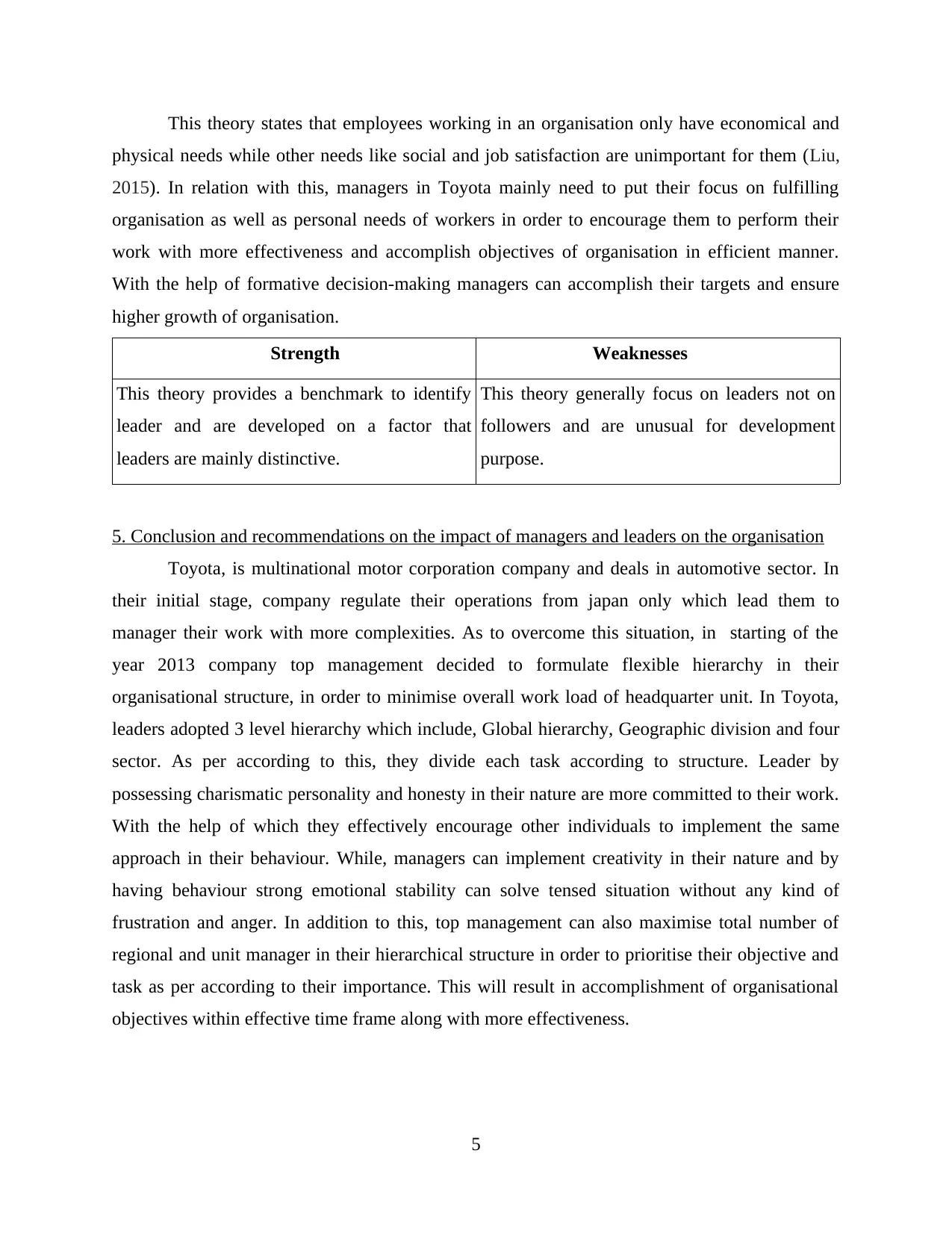
This theory states that employees working in an organisation only have economical and
physical needs while other needs like social and job satisfaction are unimportant for them (Liu,
2015). In relation with this, managers in Toyota mainly need to put their focus on fulfilling
organisation as well as personal needs of workers in order to encourage them to perform their
work with more effectiveness and accomplish objectives of organisation in efficient manner.
With the help of formative decision-making managers can accomplish their targets and ensure
higher growth of organisation.
Strength Weaknesses
This theory provides a benchmark to identify
leader and are developed on a factor that
leaders are mainly distinctive.
This theory generally focus on leaders not on
followers and are unusual for development
purpose.
5. Conclusion and recommendations on the impact of managers and leaders on the organisation
Toyota, is multinational motor corporation company and deals in automotive sector. In
their initial stage, company regulate their operations from japan only which lead them to
manager their work with more complexities. As to overcome this situation, in starting of the
year 2013 company top management decided to formulate flexible hierarchy in their
organisational structure, in order to minimise overall work load of headquarter unit. In Toyota,
leaders adopted 3 level hierarchy which include, Global hierarchy, Geographic division and four
sector. As per according to this, they divide each task according to structure. Leader by
possessing charismatic personality and honesty in their nature are more committed to their work.
With the help of which they effectively encourage other individuals to implement the same
approach in their behaviour. While, managers can implement creativity in their nature and by
having behaviour strong emotional stability can solve tensed situation without any kind of
frustration and anger. In addition to this, top management can also maximise total number of
regional and unit manager in their hierarchical structure in order to prioritise their objective and
task as per according to their importance. This will result in accomplishment of organisational
objectives within effective time frame along with more effectiveness.
5
physical needs while other needs like social and job satisfaction are unimportant for them (Liu,
2015). In relation with this, managers in Toyota mainly need to put their focus on fulfilling
organisation as well as personal needs of workers in order to encourage them to perform their
work with more effectiveness and accomplish objectives of organisation in efficient manner.
With the help of formative decision-making managers can accomplish their targets and ensure
higher growth of organisation.
Strength Weaknesses
This theory provides a benchmark to identify
leader and are developed on a factor that
leaders are mainly distinctive.
This theory generally focus on leaders not on
followers and are unusual for development
purpose.
5. Conclusion and recommendations on the impact of managers and leaders on the organisation
Toyota, is multinational motor corporation company and deals in automotive sector. In
their initial stage, company regulate their operations from japan only which lead them to
manager their work with more complexities. As to overcome this situation, in starting of the
year 2013 company top management decided to formulate flexible hierarchy in their
organisational structure, in order to minimise overall work load of headquarter unit. In Toyota,
leaders adopted 3 level hierarchy which include, Global hierarchy, Geographic division and four
sector. As per according to this, they divide each task according to structure. Leader by
possessing charismatic personality and honesty in their nature are more committed to their work.
With the help of which they effectively encourage other individuals to implement the same
approach in their behaviour. While, managers can implement creativity in their nature and by
having behaviour strong emotional stability can solve tensed situation without any kind of
frustration and anger. In addition to this, top management can also maximise total number of
regional and unit manager in their hierarchical structure in order to prioritise their objective and
task as per according to their importance. This will result in accomplishment of organisational
objectives within effective time frame along with more effectiveness.
5

TASK 2
1. Introduction to the key operations of Toyota
Every organisation have different functional structure in their workplace, and follow
certain key operations which is generally depend on their working sector. Toyota Motor
corporation, is one of the leading automotive sector and world's first automotive manufacturer.
Company also engage in other operations. In the management structure of Toyota there are
several other departmental units which include designing unit, finance, strategy, production,
forecasting, quality management unit, supply chain department and operation management unit
that affect overall performance of company in marketplace (Kato, 2014). In order to achieve
performances of every unit in effective manner managers and leaders need to implement various
concepts of approaches in their organisational structure which include, Six sigma approach, Just
in time approach and lean production. This will benefit Toyota to accomplish their objectives
and goals with more effectiveness and maximise overall productivity of company
simultaneously.
2. Roles and responsibilities of managers in the key operational functions
Manager is a person who have authority to monitor and control various units or a group
of organisation. In Toyota, managers acts as an linking bridge between company top and bottom
management level. As they transfer information of Toyota head department to low department.
With the help of various managerial skills managers in company easily perform their different
types of functions in organisation. Some basic key important functions of organisation are
mentioned below:
Finance: Finance is life blood of any organisation. As Toyota is a multinational vehicle
manufacturing corporation company have various source of finance. In order to perform
their overall organisation operations in systematic way managers need to ensure that there
is a proper and required amount of fund allocated to each departmental unit and are
utilized in effective way. For this, managers of Toyota need to formulate effective budget
with the help of which company can utilize their funds in effective manner. In addition to
this, it is the responsibility of manager to monitor the use of funds and ensure whether it
is utilized in proper way or not.
6
1. Introduction to the key operations of Toyota
Every organisation have different functional structure in their workplace, and follow
certain key operations which is generally depend on their working sector. Toyota Motor
corporation, is one of the leading automotive sector and world's first automotive manufacturer.
Company also engage in other operations. In the management structure of Toyota there are
several other departmental units which include designing unit, finance, strategy, production,
forecasting, quality management unit, supply chain department and operation management unit
that affect overall performance of company in marketplace (Kato, 2014). In order to achieve
performances of every unit in effective manner managers and leaders need to implement various
concepts of approaches in their organisational structure which include, Six sigma approach, Just
in time approach and lean production. This will benefit Toyota to accomplish their objectives
and goals with more effectiveness and maximise overall productivity of company
simultaneously.
2. Roles and responsibilities of managers in the key operational functions
Manager is a person who have authority to monitor and control various units or a group
of organisation. In Toyota, managers acts as an linking bridge between company top and bottom
management level. As they transfer information of Toyota head department to low department.
With the help of various managerial skills managers in company easily perform their different
types of functions in organisation. Some basic key important functions of organisation are
mentioned below:
Finance: Finance is life blood of any organisation. As Toyota is a multinational vehicle
manufacturing corporation company have various source of finance. In order to perform
their overall organisation operations in systematic way managers need to ensure that there
is a proper and required amount of fund allocated to each departmental unit and are
utilized in effective way. For this, managers of Toyota need to formulate effective budget
with the help of which company can utilize their funds in effective manner. In addition to
this, it is the responsibility of manager to monitor the use of funds and ensure whether it
is utilized in proper way or not.
6
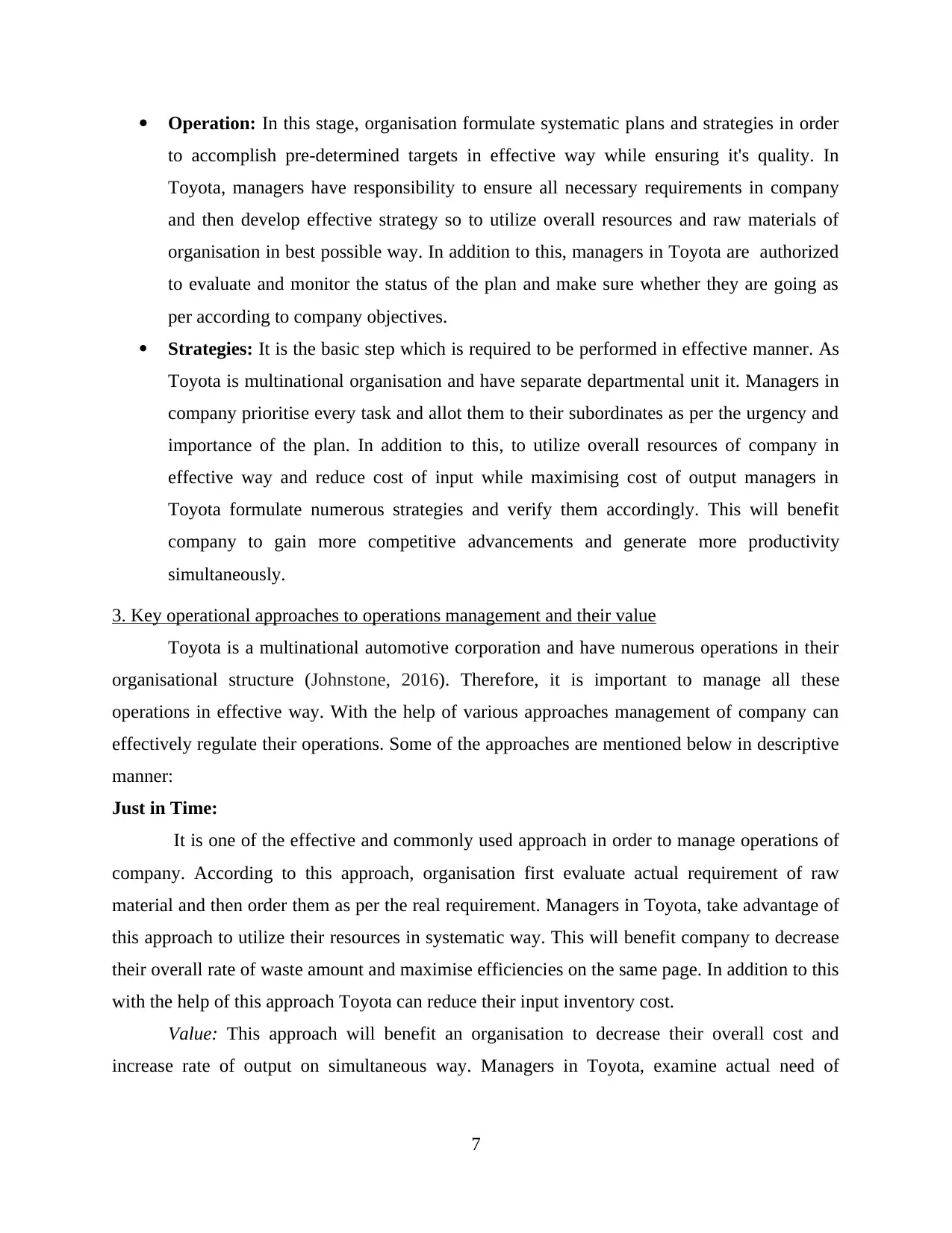
Operation: In this stage, organisation formulate systematic plans and strategies in order
to accomplish pre-determined targets in effective way while ensuring it's quality. In
Toyota, managers have responsibility to ensure all necessary requirements in company
and then develop effective strategy so to utilize overall resources and raw materials of
organisation in best possible way. In addition to this, managers in Toyota are authorized
to evaluate and monitor the status of the plan and make sure whether they are going as
per according to company objectives.
Strategies: It is the basic step which is required to be performed in effective manner. As
Toyota is multinational organisation and have separate departmental unit it. Managers in
company prioritise every task and allot them to their subordinates as per the urgency and
importance of the plan. In addition to this, to utilize overall resources of company in
effective way and reduce cost of input while maximising cost of output managers in
Toyota formulate numerous strategies and verify them accordingly. This will benefit
company to gain more competitive advancements and generate more productivity
simultaneously.
3. Key operational approaches to operations management and their value
Toyota is a multinational automotive corporation and have numerous operations in their
organisational structure (Johnstone, 2016). Therefore, it is important to manage all these
operations in effective way. With the help of various approaches management of company can
effectively regulate their operations. Some of the approaches are mentioned below in descriptive
manner:
Just in Time:
It is one of the effective and commonly used approach in order to manage operations of
company. According to this approach, organisation first evaluate actual requirement of raw
material and then order them as per the real requirement. Managers in Toyota, take advantage of
this approach to utilize their resources in systematic way. This will benefit company to decrease
their overall rate of waste amount and maximise efficiencies on the same page. In addition to this
with the help of this approach Toyota can reduce their input inventory cost.
Value: This approach will benefit an organisation to decrease their overall cost and
increase rate of output on simultaneous way. Managers in Toyota, examine actual need of
7
to accomplish pre-determined targets in effective way while ensuring it's quality. In
Toyota, managers have responsibility to ensure all necessary requirements in company
and then develop effective strategy so to utilize overall resources and raw materials of
organisation in best possible way. In addition to this, managers in Toyota are authorized
to evaluate and monitor the status of the plan and make sure whether they are going as
per according to company objectives.
Strategies: It is the basic step which is required to be performed in effective manner. As
Toyota is multinational organisation and have separate departmental unit it. Managers in
company prioritise every task and allot them to their subordinates as per the urgency and
importance of the plan. In addition to this, to utilize overall resources of company in
effective way and reduce cost of input while maximising cost of output managers in
Toyota formulate numerous strategies and verify them accordingly. This will benefit
company to gain more competitive advancements and generate more productivity
simultaneously.
3. Key operational approaches to operations management and their value
Toyota is a multinational automotive corporation and have numerous operations in their
organisational structure (Johnstone, 2016). Therefore, it is important to manage all these
operations in effective way. With the help of various approaches management of company can
effectively regulate their operations. Some of the approaches are mentioned below in descriptive
manner:
Just in Time:
It is one of the effective and commonly used approach in order to manage operations of
company. According to this approach, organisation first evaluate actual requirement of raw
material and then order them as per the real requirement. Managers in Toyota, take advantage of
this approach to utilize their resources in systematic way. This will benefit company to decrease
their overall rate of waste amount and maximise efficiencies on the same page. In addition to this
with the help of this approach Toyota can reduce their input inventory cost.
Value: This approach will benefit an organisation to decrease their overall cost and
increase rate of output on simultaneous way. Managers in Toyota, examine actual need of
7
Secure Best Marks with AI Grader
Need help grading? Try our AI Grader for instant feedback on your assignments.
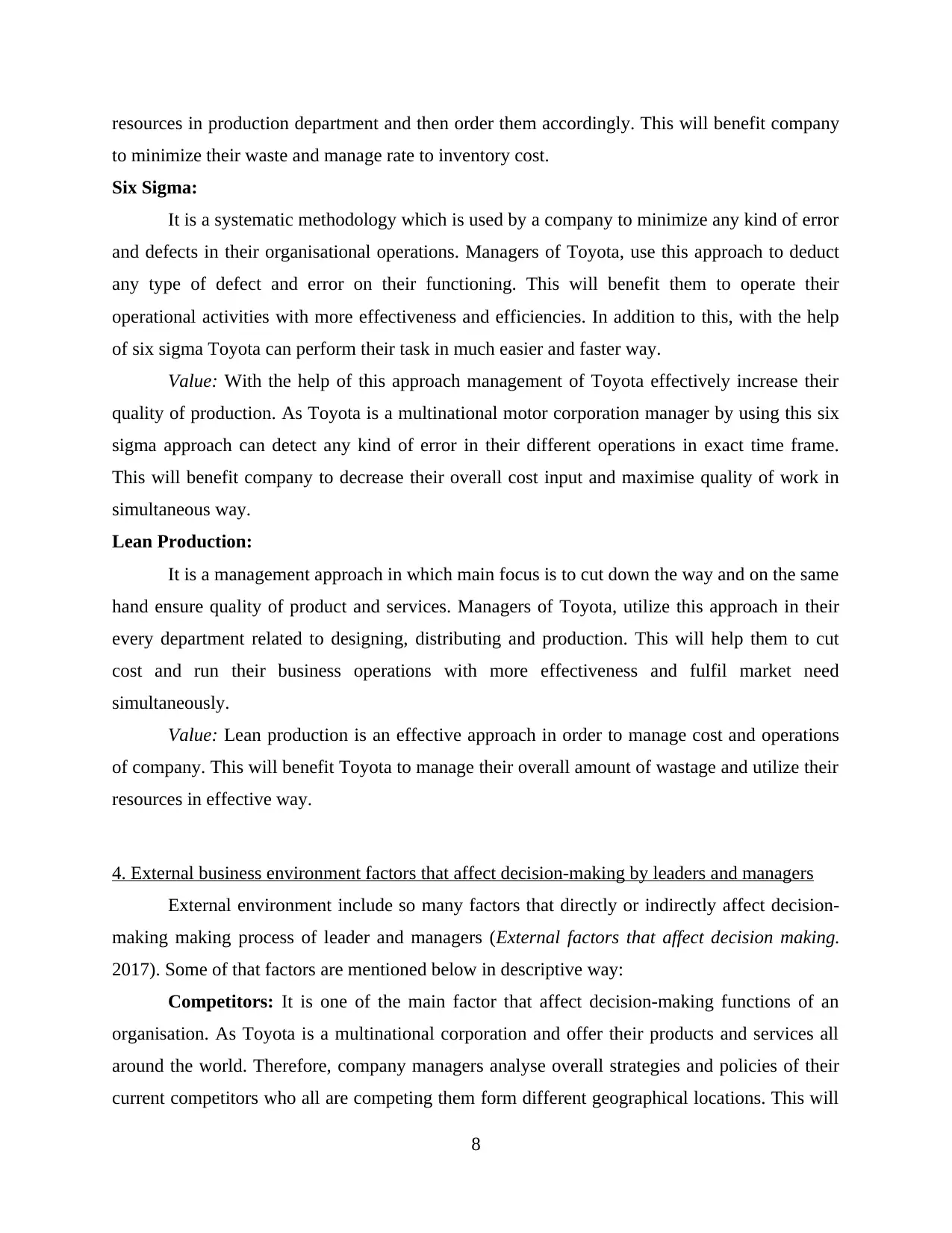
resources in production department and then order them accordingly. This will benefit company
to minimize their waste and manage rate to inventory cost.
Six Sigma:
It is a systematic methodology which is used by a company to minimize any kind of error
and defects in their organisational operations. Managers of Toyota, use this approach to deduct
any type of defect and error on their functioning. This will benefit them to operate their
operational activities with more effectiveness and efficiencies. In addition to this, with the help
of six sigma Toyota can perform their task in much easier and faster way.
Value: With the help of this approach management of Toyota effectively increase their
quality of production. As Toyota is a multinational motor corporation manager by using this six
sigma approach can detect any kind of error in their different operations in exact time frame.
This will benefit company to decrease their overall cost input and maximise quality of work in
simultaneous way.
Lean Production:
It is a management approach in which main focus is to cut down the way and on the same
hand ensure quality of product and services. Managers of Toyota, utilize this approach in their
every department related to designing, distributing and production. This will help them to cut
cost and run their business operations with more effectiveness and fulfil market need
simultaneously.
Value: Lean production is an effective approach in order to manage cost and operations
of company. This will benefit Toyota to manage their overall amount of wastage and utilize their
resources in effective way.
4. External business environment factors that affect decision-making by leaders and managers
External environment include so many factors that directly or indirectly affect decision-
making making process of leader and managers (External factors that affect decision making.
2017). Some of that factors are mentioned below in descriptive way:
Competitors: It is one of the main factor that affect decision-making functions of an
organisation. As Toyota is a multinational corporation and offer their products and services all
around the world. Therefore, company managers analyse overall strategies and policies of their
current competitors who all are competing them form different geographical locations. This will
8
to minimize their waste and manage rate to inventory cost.
Six Sigma:
It is a systematic methodology which is used by a company to minimize any kind of error
and defects in their organisational operations. Managers of Toyota, use this approach to deduct
any type of defect and error on their functioning. This will benefit them to operate their
operational activities with more effectiveness and efficiencies. In addition to this, with the help
of six sigma Toyota can perform their task in much easier and faster way.
Value: With the help of this approach management of Toyota effectively increase their
quality of production. As Toyota is a multinational motor corporation manager by using this six
sigma approach can detect any kind of error in their different operations in exact time frame.
This will benefit company to decrease their overall cost input and maximise quality of work in
simultaneous way.
Lean Production:
It is a management approach in which main focus is to cut down the way and on the same
hand ensure quality of product and services. Managers of Toyota, utilize this approach in their
every department related to designing, distributing and production. This will help them to cut
cost and run their business operations with more effectiveness and fulfil market need
simultaneously.
Value: Lean production is an effective approach in order to manage cost and operations
of company. This will benefit Toyota to manage their overall amount of wastage and utilize their
resources in effective way.
4. External business environment factors that affect decision-making by leaders and managers
External environment include so many factors that directly or indirectly affect decision-
making making process of leader and managers (External factors that affect decision making.
2017). Some of that factors are mentioned below in descriptive way:
Competitors: It is one of the main factor that affect decision-making functions of an
organisation. As Toyota is a multinational corporation and offer their products and services all
around the world. Therefore, company managers analyse overall strategies and policies of their
current competitors who all are competing them form different geographical locations. This will
8
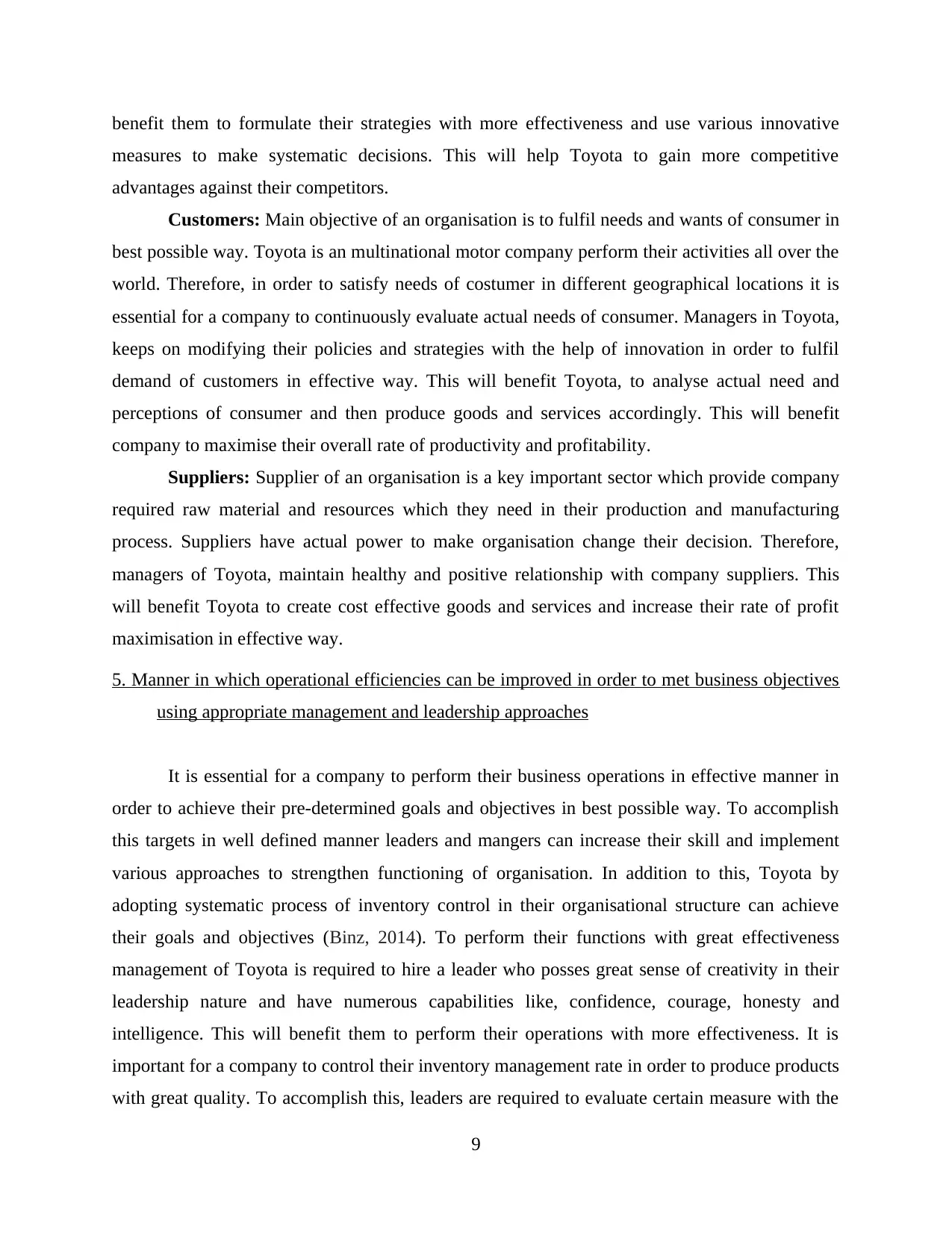
benefit them to formulate their strategies with more effectiveness and use various innovative
measures to make systematic decisions. This will help Toyota to gain more competitive
advantages against their competitors.
Customers: Main objective of an organisation is to fulfil needs and wants of consumer in
best possible way. Toyota is an multinational motor company perform their activities all over the
world. Therefore, in order to satisfy needs of costumer in different geographical locations it is
essential for a company to continuously evaluate actual needs of consumer. Managers in Toyota,
keeps on modifying their policies and strategies with the help of innovation in order to fulfil
demand of customers in effective way. This will benefit Toyota, to analyse actual need and
perceptions of consumer and then produce goods and services accordingly. This will benefit
company to maximise their overall rate of productivity and profitability.
Suppliers: Supplier of an organisation is a key important sector which provide company
required raw material and resources which they need in their production and manufacturing
process. Suppliers have actual power to make organisation change their decision. Therefore,
managers of Toyota, maintain healthy and positive relationship with company suppliers. This
will benefit Toyota to create cost effective goods and services and increase their rate of profit
maximisation in effective way.
5. Manner in which operational efficiencies can be improved in order to met business objectives
using appropriate management and leadership approaches
It is essential for a company to perform their business operations in effective manner in
order to achieve their pre-determined goals and objectives in best possible way. To accomplish
this targets in well defined manner leaders and mangers can increase their skill and implement
various approaches to strengthen functioning of organisation. In addition to this, Toyota by
adopting systematic process of inventory control in their organisational structure can achieve
their goals and objectives (Binz, 2014). To perform their functions with great effectiveness
management of Toyota is required to hire a leader who posses great sense of creativity in their
leadership nature and have numerous capabilities like, confidence, courage, honesty and
intelligence. This will benefit them to perform their operations with more effectiveness. It is
important for a company to control their inventory management rate in order to produce products
with great quality. To accomplish this, leaders are required to evaluate certain measure with the
9
measures to make systematic decisions. This will help Toyota to gain more competitive
advantages against their competitors.
Customers: Main objective of an organisation is to fulfil needs and wants of consumer in
best possible way. Toyota is an multinational motor company perform their activities all over the
world. Therefore, in order to satisfy needs of costumer in different geographical locations it is
essential for a company to continuously evaluate actual needs of consumer. Managers in Toyota,
keeps on modifying their policies and strategies with the help of innovation in order to fulfil
demand of customers in effective way. This will benefit Toyota, to analyse actual need and
perceptions of consumer and then produce goods and services accordingly. This will benefit
company to maximise their overall rate of productivity and profitability.
Suppliers: Supplier of an organisation is a key important sector which provide company
required raw material and resources which they need in their production and manufacturing
process. Suppliers have actual power to make organisation change their decision. Therefore,
managers of Toyota, maintain healthy and positive relationship with company suppliers. This
will benefit Toyota to create cost effective goods and services and increase their rate of profit
maximisation in effective way.
5. Manner in which operational efficiencies can be improved in order to met business objectives
using appropriate management and leadership approaches
It is essential for a company to perform their business operations in effective manner in
order to achieve their pre-determined goals and objectives in best possible way. To accomplish
this targets in well defined manner leaders and mangers can increase their skill and implement
various approaches to strengthen functioning of organisation. In addition to this, Toyota by
adopting systematic process of inventory control in their organisational structure can achieve
their goals and objectives (Binz, 2014). To perform their functions with great effectiveness
management of Toyota is required to hire a leader who posses great sense of creativity in their
leadership nature and have numerous capabilities like, confidence, courage, honesty and
intelligence. This will benefit them to perform their operations with more effectiveness. It is
important for a company to control their inventory management rate in order to produce products
with great quality. To accomplish this, leaders are required to evaluate certain measure with the
9
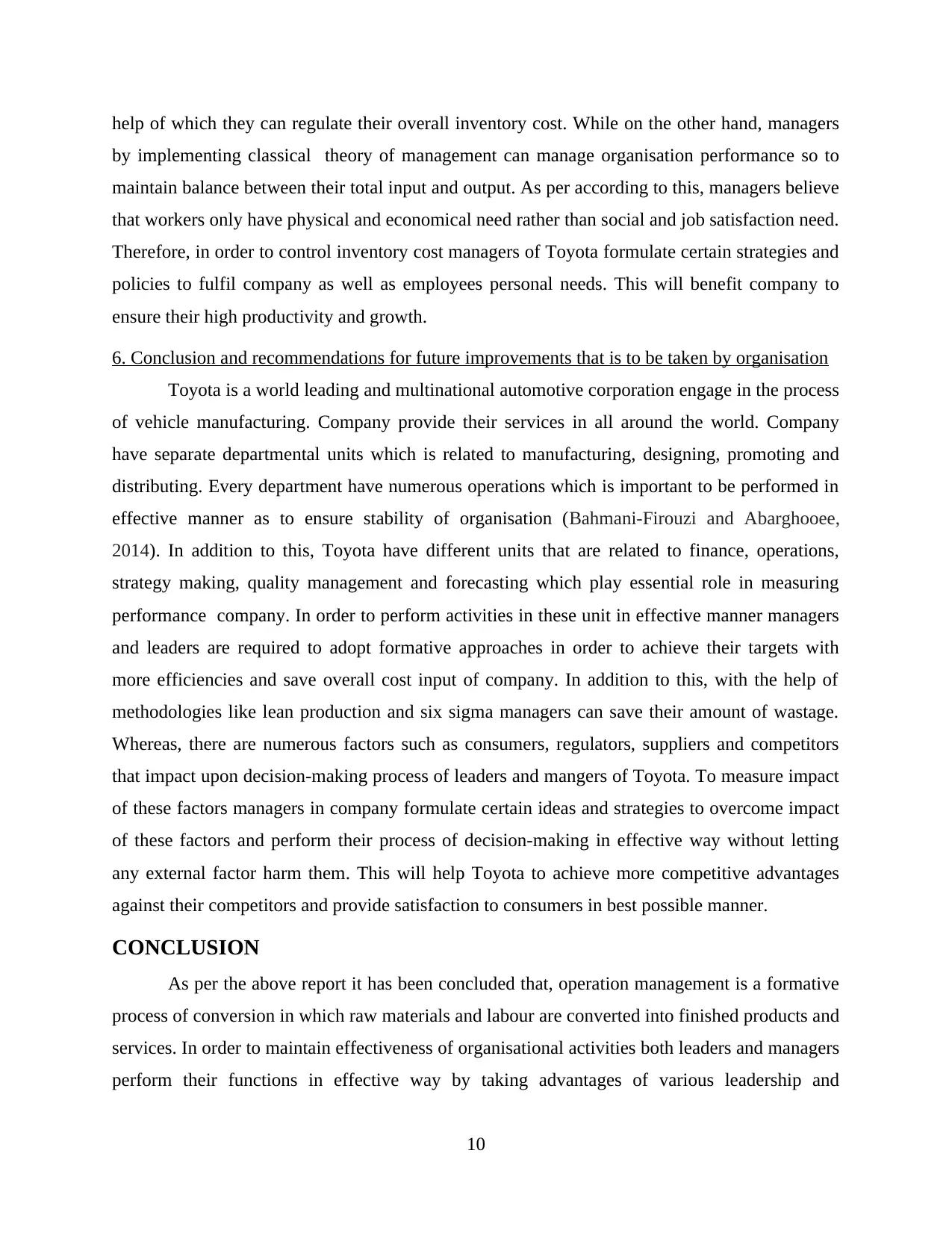
help of which they can regulate their overall inventory cost. While on the other hand, managers
by implementing classical theory of management can manage organisation performance so to
maintain balance between their total input and output. As per according to this, managers believe
that workers only have physical and economical need rather than social and job satisfaction need.
Therefore, in order to control inventory cost managers of Toyota formulate certain strategies and
policies to fulfil company as well as employees personal needs. This will benefit company to
ensure their high productivity and growth.
6. Conclusion and recommendations for future improvements that is to be taken by organisation
Toyota is a world leading and multinational automotive corporation engage in the process
of vehicle manufacturing. Company provide their services in all around the world. Company
have separate departmental units which is related to manufacturing, designing, promoting and
distributing. Every department have numerous operations which is important to be performed in
effective manner as to ensure stability of organisation (Bahmani-Firouzi and Abarghooee,
2014). In addition to this, Toyota have different units that are related to finance, operations,
strategy making, quality management and forecasting which play essential role in measuring
performance company. In order to perform activities in these unit in effective manner managers
and leaders are required to adopt formative approaches in order to achieve their targets with
more efficiencies and save overall cost input of company. In addition to this, with the help of
methodologies like lean production and six sigma managers can save their amount of wastage.
Whereas, there are numerous factors such as consumers, regulators, suppliers and competitors
that impact upon decision-making process of leaders and mangers of Toyota. To measure impact
of these factors managers in company formulate certain ideas and strategies to overcome impact
of these factors and perform their process of decision-making in effective way without letting
any external factor harm them. This will help Toyota to achieve more competitive advantages
against their competitors and provide satisfaction to consumers in best possible manner.
CONCLUSION
As per the above report it has been concluded that, operation management is a formative
process of conversion in which raw materials and labour are converted into finished products and
services. In order to maintain effectiveness of organisational activities both leaders and managers
perform their functions in effective way by taking advantages of various leadership and
10
by implementing classical theory of management can manage organisation performance so to
maintain balance between their total input and output. As per according to this, managers believe
that workers only have physical and economical need rather than social and job satisfaction need.
Therefore, in order to control inventory cost managers of Toyota formulate certain strategies and
policies to fulfil company as well as employees personal needs. This will benefit company to
ensure their high productivity and growth.
6. Conclusion and recommendations for future improvements that is to be taken by organisation
Toyota is a world leading and multinational automotive corporation engage in the process
of vehicle manufacturing. Company provide their services in all around the world. Company
have separate departmental units which is related to manufacturing, designing, promoting and
distributing. Every department have numerous operations which is important to be performed in
effective manner as to ensure stability of organisation (Bahmani-Firouzi and Abarghooee,
2014). In addition to this, Toyota have different units that are related to finance, operations,
strategy making, quality management and forecasting which play essential role in measuring
performance company. In order to perform activities in these unit in effective manner managers
and leaders are required to adopt formative approaches in order to achieve their targets with
more efficiencies and save overall cost input of company. In addition to this, with the help of
methodologies like lean production and six sigma managers can save their amount of wastage.
Whereas, there are numerous factors such as consumers, regulators, suppliers and competitors
that impact upon decision-making process of leaders and mangers of Toyota. To measure impact
of these factors managers in company formulate certain ideas and strategies to overcome impact
of these factors and perform their process of decision-making in effective way without letting
any external factor harm them. This will help Toyota to achieve more competitive advantages
against their competitors and provide satisfaction to consumers in best possible manner.
CONCLUSION
As per the above report it has been concluded that, operation management is a formative
process of conversion in which raw materials and labour are converted into finished products and
services. In order to maintain effectiveness of organisational activities both leaders and managers
perform their functions in effective way by taking advantages of various leadership and
10
Paraphrase This Document
Need a fresh take? Get an instant paraphrase of this document with our AI Paraphraser

managerial skills. In order to manage company operations managers formulate strategies and
policies and monitor performances of individuals to ascertain effectiveness of company. In
addition to this with the help of various approaches like just in time, six sigma and lean
productions company can increase their overall base of productivity and maximise their level of
proficiencies. Lastly, there are numerous external factors that affect decision making process of
both leaders and managers.
11
policies and monitor performances of individuals to ascertain effectiveness of company. In
addition to this with the help of various approaches like just in time, six sigma and lean
productions company can increase their overall base of productivity and maximise their level of
proficiencies. Lastly, there are numerous external factors that affect decision making process of
both leaders and managers.
11
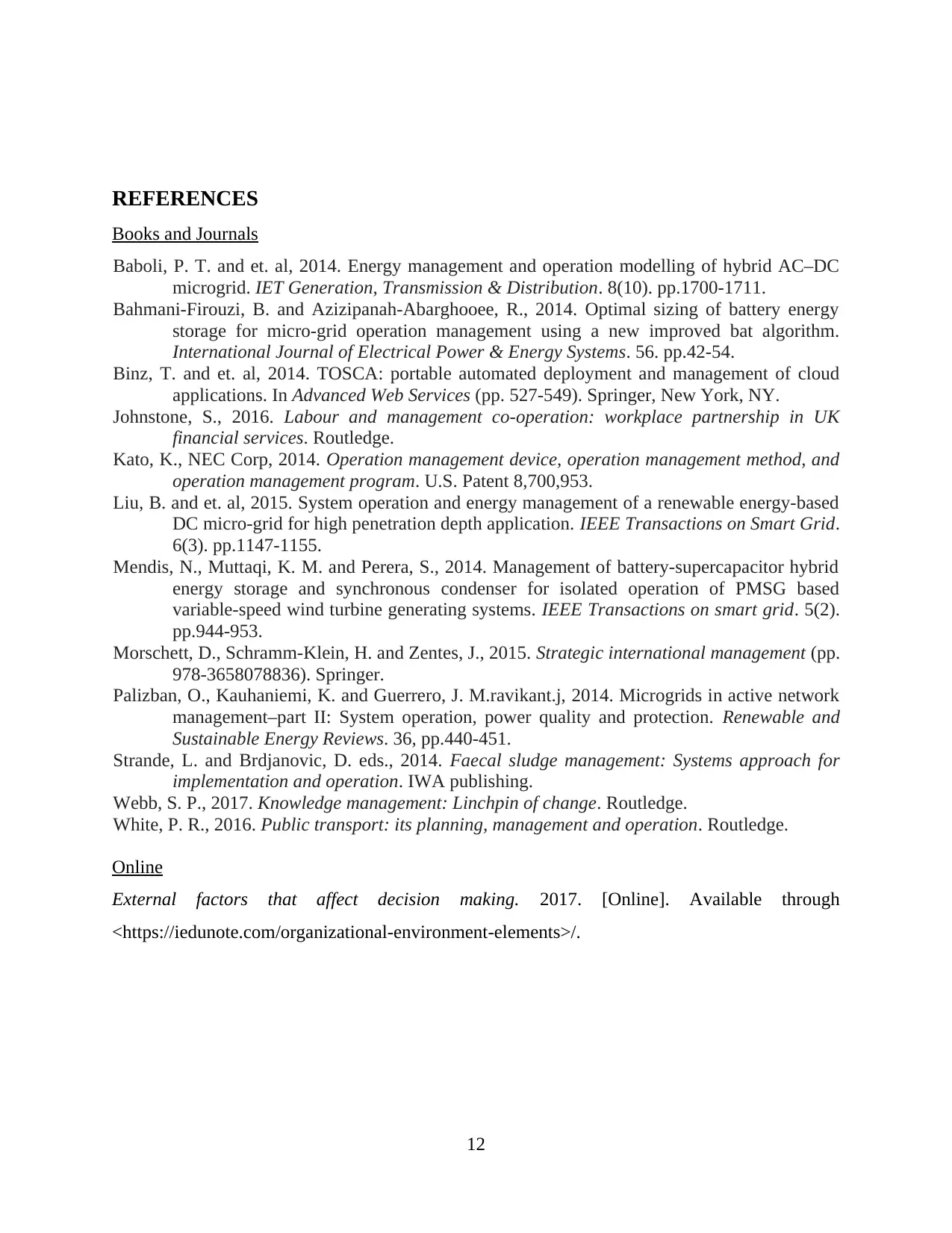
REFERENCES
Books and Journals
Baboli, P. T. and et. al, 2014. Energy management and operation modelling of hybrid AC–DC
microgrid. IET Generation, Transmission & Distribution. 8(10). pp.1700-1711.
Bahmani-Firouzi, B. and Azizipanah-Abarghooee, R., 2014. Optimal sizing of battery energy
storage for micro-grid operation management using a new improved bat algorithm.
International Journal of Electrical Power & Energy Systems. 56. pp.42-54.
Binz, T. and et. al, 2014. TOSCA: portable automated deployment and management of cloud
applications. In Advanced Web Services (pp. 527-549). Springer, New York, NY.
Johnstone, S., 2016. Labour and management co-operation: workplace partnership in UK
financial services. Routledge.
Kato, K., NEC Corp, 2014. Operation management device, operation management method, and
operation management program. U.S. Patent 8,700,953.
Liu, B. and et. al, 2015. System operation and energy management of a renewable energy-based
DC micro-grid for high penetration depth application. IEEE Transactions on Smart Grid.
6(3). pp.1147-1155.
Mendis, N., Muttaqi, K. M. and Perera, S., 2014. Management of battery-supercapacitor hybrid
energy storage and synchronous condenser for isolated operation of PMSG based
variable-speed wind turbine generating systems. IEEE Transactions on smart grid. 5(2).
pp.944-953.
Morschett, D., Schramm-Klein, H. and Zentes, J., 2015. Strategic international management (pp.
978-3658078836). Springer.
Palizban, O., Kauhaniemi, K. and Guerrero, J. M.ravikant.j, 2014. Microgrids in active network
management–part II: System operation, power quality and protection. Renewable and
Sustainable Energy Reviews. 36, pp.440-451.
Strande, L. and Brdjanovic, D. eds., 2014. Faecal sludge management: Systems approach for
implementation and operation. IWA publishing.
Webb, S. P., 2017. Knowledge management: Linchpin of change. Routledge.
White, P. R., 2016. Public transport: its planning, management and operation. Routledge.
Online
External factors that affect decision making. 2017. [Online]. Available through
<https://iedunote.com/organizational-environment-elements>/.
12
Books and Journals
Baboli, P. T. and et. al, 2014. Energy management and operation modelling of hybrid AC–DC
microgrid. IET Generation, Transmission & Distribution. 8(10). pp.1700-1711.
Bahmani-Firouzi, B. and Azizipanah-Abarghooee, R., 2014. Optimal sizing of battery energy
storage for micro-grid operation management using a new improved bat algorithm.
International Journal of Electrical Power & Energy Systems. 56. pp.42-54.
Binz, T. and et. al, 2014. TOSCA: portable automated deployment and management of cloud
applications. In Advanced Web Services (pp. 527-549). Springer, New York, NY.
Johnstone, S., 2016. Labour and management co-operation: workplace partnership in UK
financial services. Routledge.
Kato, K., NEC Corp, 2014. Operation management device, operation management method, and
operation management program. U.S. Patent 8,700,953.
Liu, B. and et. al, 2015. System operation and energy management of a renewable energy-based
DC micro-grid for high penetration depth application. IEEE Transactions on Smart Grid.
6(3). pp.1147-1155.
Mendis, N., Muttaqi, K. M. and Perera, S., 2014. Management of battery-supercapacitor hybrid
energy storage and synchronous condenser for isolated operation of PMSG based
variable-speed wind turbine generating systems. IEEE Transactions on smart grid. 5(2).
pp.944-953.
Morschett, D., Schramm-Klein, H. and Zentes, J., 2015. Strategic international management (pp.
978-3658078836). Springer.
Palizban, O., Kauhaniemi, K. and Guerrero, J. M.ravikant.j, 2014. Microgrids in active network
management–part II: System operation, power quality and protection. Renewable and
Sustainable Energy Reviews. 36, pp.440-451.
Strande, L. and Brdjanovic, D. eds., 2014. Faecal sludge management: Systems approach for
implementation and operation. IWA publishing.
Webb, S. P., 2017. Knowledge management: Linchpin of change. Routledge.
White, P. R., 2016. Public transport: its planning, management and operation. Routledge.
Online
External factors that affect decision making. 2017. [Online]. Available through
<https://iedunote.com/organizational-environment-elements>/.
12
1 out of 15
Related Documents
Your All-in-One AI-Powered Toolkit for Academic Success.
+13062052269
info@desklib.com
Available 24*7 on WhatsApp / Email
![[object Object]](/_next/static/media/star-bottom.7253800d.svg)
Unlock your academic potential
© 2024 | Zucol Services PVT LTD | All rights reserved.





